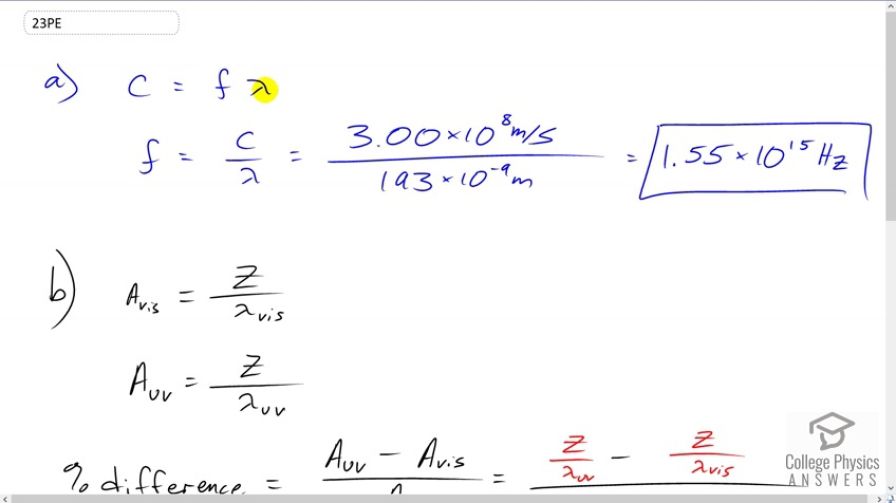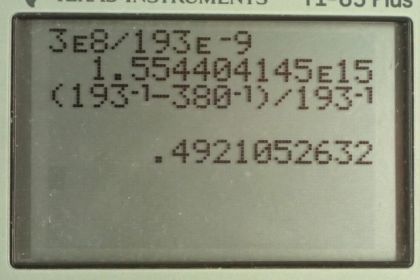Question
(a) What is the frequency of the 193-nm ultraviolet radiation used in laser eye surgery? (b) Assuming the accuracy with which this EM radiation can ablate the cornea is inversely proportional to wavelength, how much more accurate can this UV be than the shortest visible wavelength of light?
Final Answer
- The UV light is 49% more accurate.
Solution video
OpenStax College Physics, Chapter 24, Problem 23 (Problems & Exercises)

vote with a rating of
votes with an average rating of
.
Calculator Screenshots
Video Transcript
This is College Physics Answers with Shaun Dychko. The type of laser you use to do eye surgery is called an excimer laser and we are going to calculate what its frequency is giving its Ultraviolet wavelength of 193 nano-meters. So, we have the wave equation says speed of light equals the light’s frequency times its wavelength and we can solve for f by dividing both sides by lambda and then we have frequency is speed of light divided by lambda says three times ten to the eight meter per second divided by 193 times ten to the minus nine meters which is 1.55 times ten to the 15 hertz. In part B, there is a bit of a problem with the way the textbook word the question. It says assuming the accuracy of this EM radiation can ablate the cornea is directly proportional to the wavelength, how much more accurate can this UV be than the shortest visible wavelength of light? And so there is a contradiction between it saying that accuracy is directly proportional to wavelength and saying that the UV is more accurate because the UV has a shorter wavelength than the visible light and so this is a contradiction to say that how much more accurate can this thing with the short wavelength be if you also say that accuracy is proportional to wavelength meaning that short wavelength should be less accurate when you have something directly proportional, that means as the thing gets smaller, the thing that is directly proportional to also get smaller nd so this UV light should be less accurate if this is true. So, what they meant to say is that the accuracy is inversely proportional to wavelength. It is true that the Ultraviolet light is more accurate, and the shorter wavelength is more accurate and so that means that accuracy is inversely proportional to wavelength such that the smaller wavelength causes an increase in accuracy. So, we are going to interpret the question that way that accuracy is inversely proportional to the wavelength and so that means the accuracy, I put the capital letter A for accuracy, for visible light is some constant of proportionality z which we don’t really care what it is because it's gonna cancel anyway when we find the percent difference between these two. It’s z divided by the wavelength of visible light and so this is to say inversely proportional such that as wavelength decreases, as the denominator of the fraction goes down, the quotient goes up and so the accuracy for Ultraviolet light is gonna be some the same proportionality constant divided by the wavelength of Ultraviolet light and now the percent difference in accuracy between these two is gonna be the accuracy of the UV minus the accuracy of the visible light divided by the accuracy of the UV and so we substitute each of these fractions in here. So, we have z over lambda uv minus z over lambda visible divided by z over lambda uv gives us the, well, fractional difference to be precise but we can multiply by 100 to turn it into a percent difference and so the zs cancel on top and bottom, so we have one over lambda uv minus one over lambda visible divided by one over lambda uv is going to be our answer. So, it’s one over 193 nano-meters one over the shortest visible wavelength which is 380 nano-meters, that must be violet or indigo, and divided that by one over 193 nano-meters and this works out to 0.49 which is 49%. So, the Ultraviolet light is 49% more accurate than the shortest visible wavelength.
